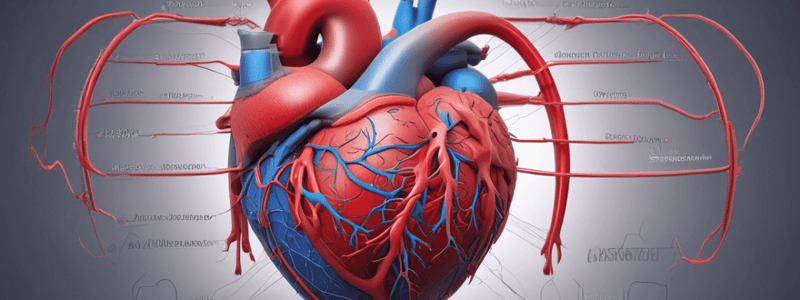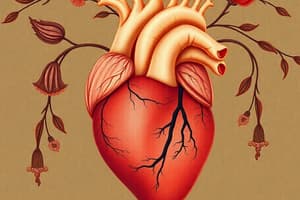Podcast
Questions and Answers
CO = (72 beats per ______) x (0.07 liters per beat)
CO = (72 beats per ______) x (0.07 liters per beat)
minute
Dr. Nguyen pointed out that ______ volume is most often represented in milliliters, while cardiac output is most often represented in liters.
Dr. Nguyen pointed out that ______ volume is most often represented in milliliters, while cardiac output is most often represented in liters.
stroke
______ output is the same for both the right and left sides of the heart, even though they are involved in different circuits, because blood flows between the circuits in series.
______ output is the same for both the right and left sides of the heart, even though they are involved in different circuits, because blood flows between the circuits in series.
Cardiac
Even as little as 1% ______ could have a profound negative impact on the body by causing a backup in either the pulmonary or systemic circuit.
Even as little as 1% ______ could have a profound negative impact on the body by causing a backup in either the pulmonary or systemic circuit.
This would increase the ______ throughout your pulmonary circulation, and you would eventually die because your lungs would "drown" from the inside due to pulmonary edema.
This would increase the ______ throughout your pulmonary circulation, and you would eventually die because your lungs would "drown" from the inside due to pulmonary edema.
During isovolumetric relaxation, the semilunar valves close and the volume of blood in the ventricles is not changing, representing a stage of ______.
During isovolumetric relaxation, the semilunar valves close and the volume of blood in the ventricles is not changing, representing a stage of ______.
If the ventricles were to stop contracting, blood flow would stop, and you would die due to the absence of ______ pressure.
If the ventricles were to stop contracting, blood flow would stop, and you would die due to the absence of ______ pressure.
The ventricles re-fill during ventricular filling to maintain adequate ______ volume for proper circulation.
The ventricles re-fill during ventricular filling to maintain adequate ______ volume for proper circulation.
A measure of 40 mm Hg in ventricular pressure could really be an absolute pressure of 800 mm Hg, indicating the importance of understanding ______ volume.
A measure of 40 mm Hg in ventricular pressure could really be an absolute pressure of 800 mm Hg, indicating the importance of understanding ______ volume.
Atrial pressure changes modestly compared to ventricular pressure throughout the cardiac cycle, emphasizing the significance of monitoring ventricular ______.
Atrial pressure changes modestly compared to ventricular pressure throughout the cardiac cycle, emphasizing the significance of monitoring ventricular ______.
Mean arterial pressure (MAP) is the weighted ______ pressure occurring in the aorta during a cardiac cycle.
Mean arterial pressure (MAP) is the weighted ______ pressure occurring in the aorta during a cardiac cycle.
The difference in end-diastolic volume (EDV) and end-systolic volume (ESV) represents the ______ of blood ejected from the heart during one cardiac cycle.
The difference in end-diastolic volume (EDV) and end-systolic volume (ESV) represents the ______ of blood ejected from the heart during one cardiac cycle.
Ejection Fraction (EF) = ______ Volume/End-Diastolic Volume
Ejection Fraction (EF) = ______ Volume/End-Diastolic Volume
More time is spent ______ than contracting in the cardiac cycle.
More time is spent ______ than contracting in the cardiac cycle.
The ______ pressure is given more weight than the systolic pressure in the calculation of mean arterial pressure.
The ______ pressure is given more weight than the systolic pressure in the calculation of mean arterial pressure.
The ______ is the maximum pressure in the aorta during the cardiac cycle.
The ______ is the maximum pressure in the aorta during the cardiac cycle.
The ______ is the lowest blood pressure in the aorta during the cardiac cycle.
The ______ is the lowest blood pressure in the aorta during the cardiac cycle.
The closure of the AV valves marks the beginning of ______ contraction.
The closure of the AV valves marks the beginning of ______ contraction.
The ______ peaks at the point where the heart has emptied its blood.
The ______ peaks at the point where the heart has emptied its blood.
The ______ opens when the ventricular pressure is greater than the aortic pressure.
The ______ opens when the ventricular pressure is greater than the aortic pressure.
Flashcards are hidden until you start studying



